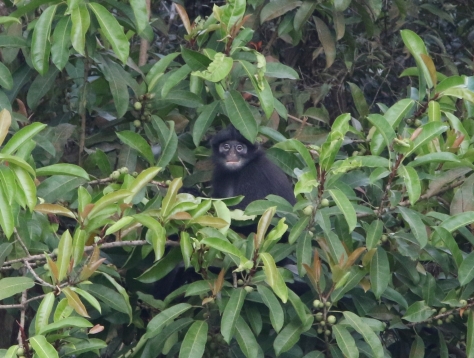They can’t say for sure how old he is, or how healthy he is. They’re not certain which trees he sleeps in at night. But they know he is alone, and that’s how they knew to call him Samurai.
The Raffles’ Banded Langur Working Group couldn’t exist without pure optimism. Deforestation and urbanization have pushed the native critically endangered Raffles’ Banded Langur population further and further into the Central Catchment Nature Reserve, where they have dwindled down to fifty individuals. On top of that, the working group discovered in early 2018 that a male individual had been separated from his troop, and was wandering an isolated patch of forest alone. During my brief time as an intern at the Jane Goodall Institute (Singapore), I stumbled over roots and pricked my fingers on thorns as I followed the volunteers, combing the forest patch, mornings and afternoons, day after day, for the slightest sign of him.
Here’s what it all comes down to: we need every single Raffles’ Banded Langur out there; every individual that carries the genes of the Presbytis femoralis femoralis is precious. A lost male is a lost parent is a lost generation. Samurai has to be taken out of that isolated forest patch where no one but a troop of wary macaques even remotely looks like him, and returned to his own troop.
The key is the sleeping tree. When a volunteer spots him resting on a tree, a ribbon goes around that trunk. Sometimes the trees are so old that it takes two of us on either side, giving its wide girth as tight a bear hug as we can manage, so that our outstretched fingers can meet each other just long enough to pass the ribbon over. We do this over and over, because we’re not sure which ones he sleeps in at night, which ones he naps in, and which ones he just plain sits and takes a dump in. Most shifts, we don’t even see him, just the bounce in the canopy as he bolts from our sight, leaving us with a heavy rustling. But once the all-important tree is identified, a team of specialists will sneak into the forest before dawn and gather around it. They will scan the overhead boughs for Samurai’s sleeping form. They will aim and shoot a tranquilizing dart, and if all goes well, he will be falling into a net and whisked away before he even begins to understand that something’s out of the ordinary.
Once he’s determined to be healthy, he will be reunited with his troop. That is, if all goes well. If they ever find his sleeping tree. If he doesn’t get spooked and abandon his usual haunts. It would all be so much easier if they could just read his mind, but you don’t try to get into the head of a wild animal the way you invent gadgets to translate dog barks. You observe and take notes and do what you can, because you weren’t evolved to be best buddies or to gently place your hands palm to palm like in Tarzan. You’re just two components of the same world. In Singapore, not many of us become close friends with our neighbours. But we sweep the corridor and press the lift button for each other and turn down the music at night.
On my last ever shift, I was re-entering the forest for a second round, and a silhouette leapt from a disturbance in the canopy and landed on a branch just a few metres from me, low enough that I only had to raise my head a little to see. My eyes were caught off guard and unfocused, but I remember that our gazes met. I turned to softly call my companion, and then he was already nothing more than the sound of branches crashing in the distance. You must have seen the ubiquitous Long-tailed Macaque before, so imagine this: twice as large, black hair instead of brown, tinged very slightly with purple. Limbs somehow stockier. Tail always longer than you expect; white smudges on the abdomen and the inner sides of the arms and legs. Quiet, inscrutable.

Photo: Sabrina Jabbar
Written by: Qiu Jiahui
